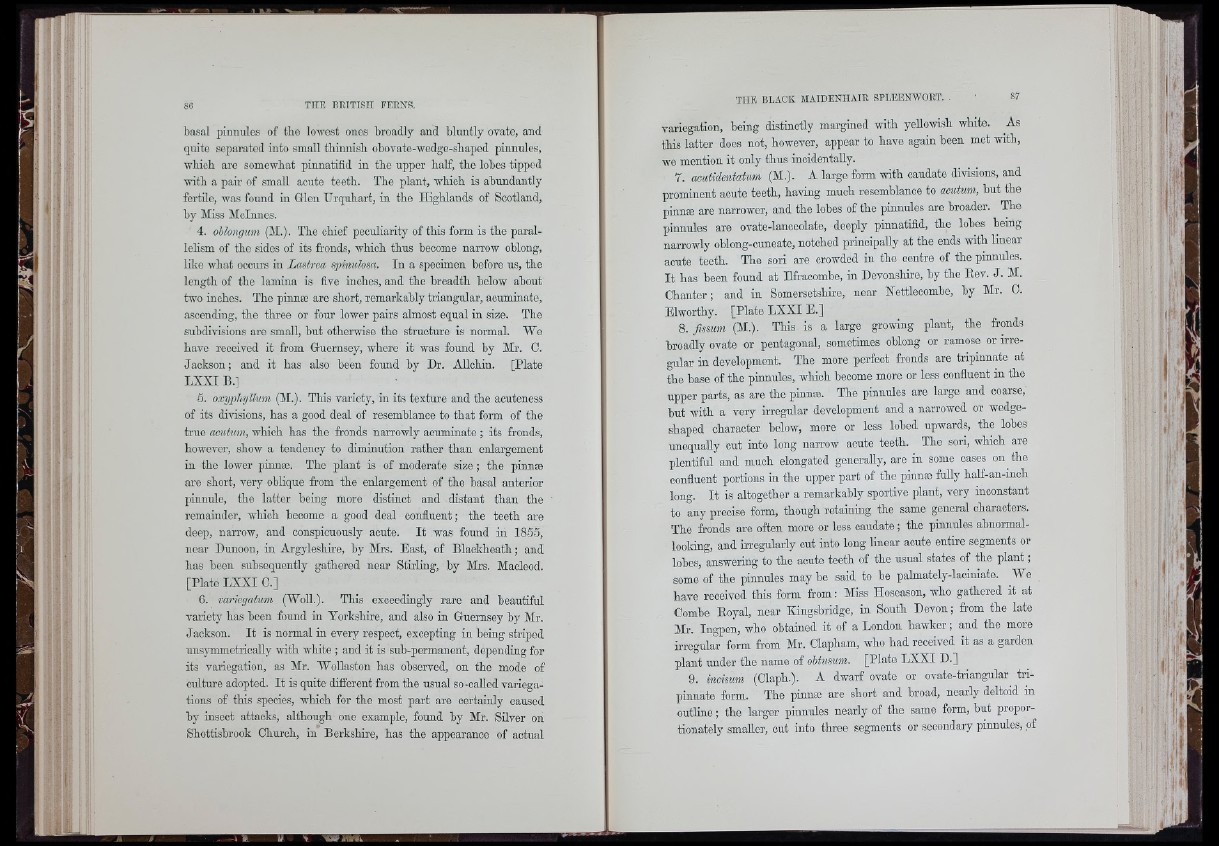
SG THE BRITISH FERNS.
basal pinnules of the lowest ones broadly and bluntly ovate, and
quite separated into small thinnish ohovate-wcdgc-shaped pinnules,
which are somewhat pinnatifid in the upper half, the lobes tipped
mth a pair of small acuto teeth. The plant, which is abundantly
fertile, was found in Glen TJrquhart, in tho Highlands of Scotland,
by Miss Molnncs.
4. oblongum (M.). The chief peculiarity of this form is the parallelism
of the sides of its fronds, which thus become narrow oblong,
like what occurs in Lastrea spiniilosa. In a specimen before us, the
length of the lamina is five inches, and the breadth below about
two inches. The pinnæ are short, remarkably triangular, acuminate,
ascending, the three or four lower pairs almost equal in size. The
subdivisions are small, but otherwise the structure is normal. We
have received it from Guernsey, where it was found by Mr. 0.
Jackson ; and it has also been found by Dr. Allchin. [Plato
LXXI B.]
5. oxypliyllum (M.). This variety, in its texture and the acuteness
of its divisions, has a good deal of resemblance to that form of the
true acutum, which has the fronds narrowly acuminate ; its fronds,
however, show a tendency to diminution rather than enlargement
in the lower pinnæ. The plant is of moderate size ; the pinnæ
aro short, very oblique from the enlargement of the basal anterior
pinnule, the latter being more distinct and distant than tho
remainder, which become a good deal confluent ; the teeth are
deep, narrow, and conspicuously acute. It was found in 1856,
near Dunoon, in Argyleshire, by Mrs. East, of Blackheath ; and
has been subsequently gathered near Stirling, by Mrs. Macleod.
[Plate LXXI C.]
6. variegatmn (WolL). This exceedingly rare and beautiful
variety has been found in Yorkshire, and also in Guernsey by Mr.
Jackson. It is normal in every respect, excepting in being striped
unsymmetrically with white ; and it is suh-permanent, depending for
its variegation, as Mr. Wollaston has observed, on the mode of
culture adopted. It is quite différent from the usual so-called variegations
of this species, which for the most part are certainly caused
by insect attacks, although one example, found by Mr. Silver on
Shottisbrook Church, in Berkshire, has the appearance of actual
variegation, being distinctly margined with yellowish white. As
this latter does not, however, appear to have again been met with,
we mention it only thus incidentally.
7. acutidentatum (M.). A large form with caudate divisions, and
prominent acute teeth, having much resemblance to acutum, but the
pinnæ are narrower, and tho lobes of the pinnules are broader. The
pinnules are ovate-lanceolate, deeply pinnatifid, the lobes being
narrowly oblong-ouneate, notched principally at the ends with linear
acute teeth. The sori are crowded in the centre of the pinnules.
It has been found at Ilfraoomhe, in Devonshire, by the Rev. J. M.
Chanter; and in Somersetshire, near Nettlecombe, by Mr. C.
Elworthy. [Plate LXXI E.]
8. fissum (M.). This is a large growing plant, the fronds
broadly ovate or pentagonal, sometimes oblong or ramose or irregular
in development. The more perfect fronds are tripinnate at
the base of the pinnules, which become more or less confluent in tho
upper parts, as are the pinnæ. The pinnules are large and coarse,
but with a very irregular development and a narrowed or wedge-
shaped character below, more or less lobed upwards, tbe lobes
unequally cut into long narrow acute teeth. The sori, which are
plentiful and much elongated generally, are in some cases on the
confluent portions in the upper part of the pinnæ fully half-an-inch
long. It is altogether a remarkably sportive plant, very inconstant
to any precise form, though retaining the same general characters.
The fronds are often more or less caudate ; the pinnules abnormal-
looldng, and irregularly out into long linear acute entire segments or
lobes, answering to tbe acute teeth of the usual states of the plant ;
some of the pinnules may be said to be palmately-laoiniate. We
have received this form from : Miss Hoseason, who gathered it at
Combe Royal, near Kingsbridge, in South Devon; from the late
Mr. Ingpen, who obtained it of a London hawker ; and the more
irregular form from Mr. Clapham, who had reooived it as a garden
plant under the name of obtusum. [Plate LXXI D.]
9. incisum (Claph.). A dwarf ovate or ovate-triangular tri-
piunate form. The pinnæ are short and broad, nearly deltoid in
outline ; the larger pinnules nearly of the same form, but proportionately
smaller, out into threo segments or secondary pinnules, of
I
i; I ; .
I I
i ï \
I
i:!*'
C)
ill
/ i'
■ ;•
; ■ 11
; / ? l
(' ■ ;